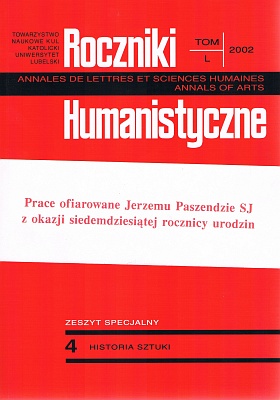The Sculptor Thomas Hutter, the Unrealized Jesuit Missionary
Abstract
In the Roman Central Jesuit Archive (ARSI) two letters by the Jesuit sculptor Thomas Hutter (1696-1745) of 1722 and 1723 have been preserved. They were written from the Sandomierz college to the General of the order, Michelangelo Tamburini. After the noviciate at St Szczepan Home in Cracow in 1718-1720 in the autumn of 1720 Thomas Hutter was transferred from Cracow to the Sandomierz college as a so-called coaudiutor temporalis. This was connected with the needs of the Sandomierz Jesuits who in 1717 took over the Gothic St Peter church from the parish. The Jesuit sculptor was welcome in Sandomierz as there was enough work for him in the church for many years. In Hutter’s long stay in Sandomierz that lasted till 1727 and was filled with work, about 1722 a clear crisis appeared. The discussed letters are proof of this. The first of them is a response to the offer that the order authorities sent to particular Jesuit homes, connected with a possibility of work in foreign missions. Hutter said he was ready to go to foreign missions, although he did not define the country he wanted to work in. At the same time he asked to be transferred to the German Province jurisdiction. In the second letter the artist repeated his request, this time suggesting a region for the mission. It was to be Turkey or countries subjected to it, like the Crimean Khanate. Hutter said he was going to learn the language and offered his work not only strictly as a missionary but he was ready to be a spy in Turkey as well. He was not afraid of death or imprisonment; he asked the authorities not to worry about him in such a case. He was ready to cross the Turkish border in summer 1723. However, the whole project was not put into effect. The sculptor remained in Poland and did not give up his job. However, a few years later he decided to leave the order and start a family; he also established a lay, excellently prospering workshop. The discussed correspondence is an exceptionally rare – in the Polish reality of the 17th-18th centuries – example of preservation of a sculptor’s letters. The more surprising are the letters written by a Jesuit sculptor, especially to the supreme authorities of the Order. The problems mentioned in them, the way they are formulated and the vastness of the letters show the person of Thomas Hutter from a surprising angle, as a religious, courageous, broad-minded man with various interests and talents. All this takes us far from the stereotype of a sculptor’s quiet work and of stabilization offered by the service in a religious order. Work in missions never belonged to the easiest ones, and in Muslim countries, openly hostile to Christianity, it must have been linked with the sense of constant threat, which Hutter realized, as his second letter shows.
Copyright (c) 2002 Roczniki Humanistyczne

This work is licensed under a Creative Commons Attribution-NonCommercial-NoDerivatives 4.0 International License.





